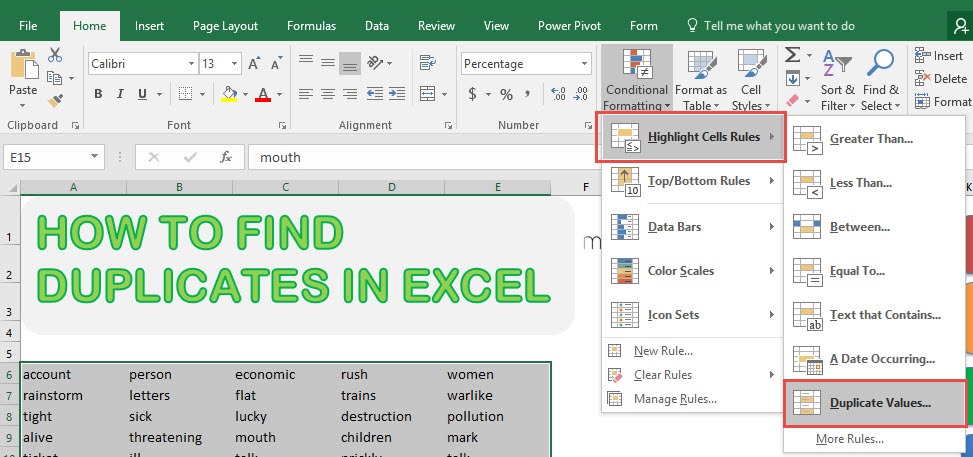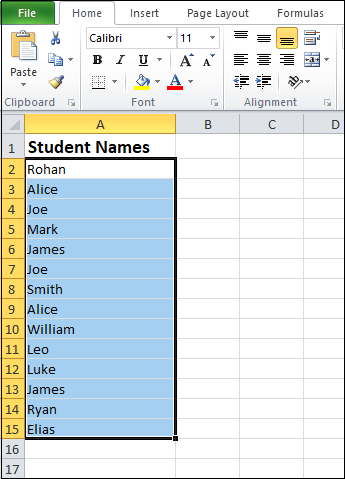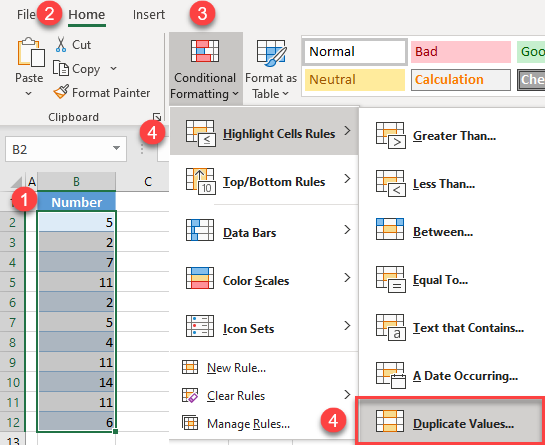
- How can excel find duplicates how to#
- How can excel find duplicates download#
I chose blue data bars, which makes the data look like this:
Go to Home –> Conditional Formatting –> Data Bars –> Choose a colour. Select all the values in the Duplicates column of the table. With the data now in an Excel table, we can make the duplicates even more obvious by applying some conditional formatting to the table. Click the drop down arrow on the Index column –> Sort Ascending. That came through with the All Rows step, so let’s put our data back into its original order. It’s for this reason that we added the Index column earlier. Maybe we want to know where they exist in an inventory count or we have some other reason for wanting to preserve the original sort order of our data. That’s not exactly a desirable outcome, as we are trying to flag duplicates for a reason. Let’s look at this output a bit more closely… Step 4: Final Cleanupīut hang on a second. Uncheck the option to “Use original column name as prefix”Īs you can see, this will bring back all the details we lost earlier. Uncheck the SKU Number option (as we already have it).  Click the Expand button at the top right of the ProductDetail column. Remember how we added a new step to show “All Rows” for the ProductDetail column? That step gave us the ability to do something pretty cool… it gave us the ability to get back all the lost records and product detail information we’re currently missing. Step 3: Identify Duplicates and Show Duplicate Records Since the whole point of this exercise was to Identify Duplicates but not remove the duplicate records, we’re still not in a good place. When we grouped our records, we lost both the Brand names column, but also any duplicate records. We’re now seeing that SKU 510010 appears to have 1 duplicate entry in the data set.īut there is still an issue here. Select the Duplicates column –> Transform –> Subtract –> 1. That would give us a truer representation as to how many duplicates there are. Let’s tweak this a bit, and subtract 1 from each value. When you’re done, the dialog should look like this:Īnd upon clicking OK, the results will show that there are, indeed, items that show up more than once:
Click the Expand button at the top right of the ProductDetail column. Remember how we added a new step to show “All Rows” for the ProductDetail column? That step gave us the ability to do something pretty cool… it gave us the ability to get back all the lost records and product detail information we’re currently missing. Step 3: Identify Duplicates and Show Duplicate Records Since the whole point of this exercise was to Identify Duplicates but not remove the duplicate records, we’re still not in a good place. When we grouped our records, we lost both the Brand names column, but also any duplicate records. We’re now seeing that SKU 510010 appears to have 1 duplicate entry in the data set.īut there is still an issue here. Select the Duplicates column –> Transform –> Subtract –> 1. That would give us a truer representation as to how many duplicates there are. Let’s tweak this a bit, and subtract 1 from each value. When you’re done, the dialog should look like this:Īnd upon clicking OK, the results will show that there are, indeed, items that show up more than once: 
New column name: Duplicates –> All Rows.Next, click the + to the right of the “New Column Name” section to add another detail row. New column name: Duplicates –> Count Rows.NOTE: We cover the Grouping feature in Chapter 14 of M is for Data Monkey. The trick here is to use the Group By feature in Power Query, while preserving the relevant matching records. Step 2: Indentify Duplicates via Grouping Rows
How can excel find duplicates how to#
Now we need to figure out how to flag any repeating SKU as a duplicate. To to Add Column –> Add Index Column –> From 0.The reason will become apparent later, but for now: This might seem like an odd step right now, but we’re going to add a Index column to this table as well.

Changed Type (setting the data types for the columns).The data will be loaded in to Power Query, and you’ll see two steps in the Applied Steps window: Of course we’ll start by pulling the data in to Power Query

I’m carving off one method that is the easiest to replicate via the user interface… Step 1: Link to the Data Naturally, there will be a few different ways to do this. Instead you’d like to identify which records have duplicate entries in the list. While it would be easy to just hit the SKU column with the Remove Duplicates function, you don’t want to do that. While the list provided to you was supposed to be duplicate free, you’re not 100% sure that it actually is. While multiple brands are okay here, we need a list that shows only unique SKU numbers.
How can excel find duplicates download#
Suppose someone has given you a list like the one shown below (which you can download here if you’d like to follow along): Some time ago I got an email from Alex asking me if there was a way to identify duplicates using Power Query, but without removing non-duplicate records in the process.








 0 kommentar(er)
0 kommentar(er)
